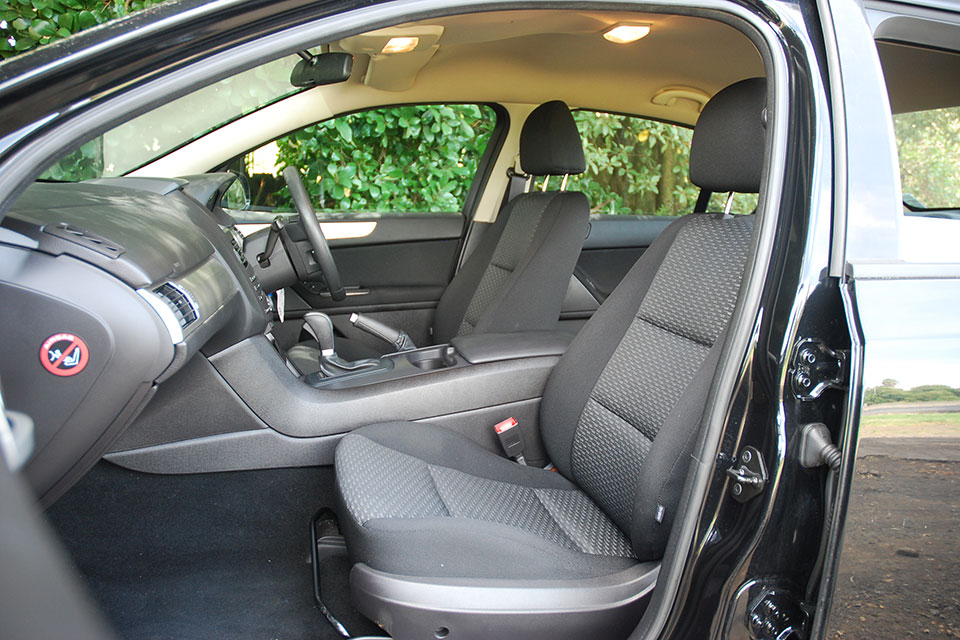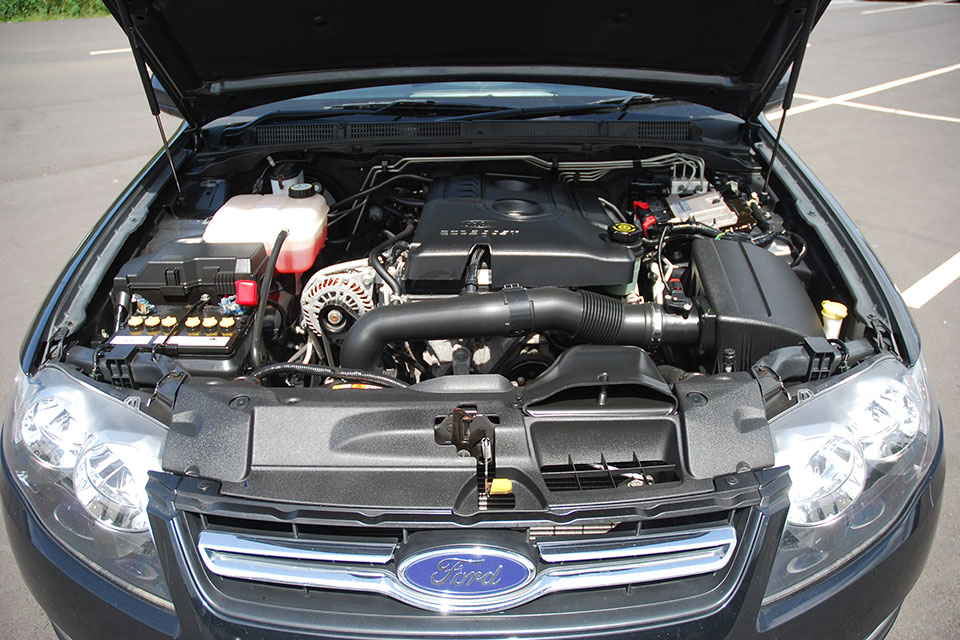Ford Falcon Ecoboost 2008-2014 used car review
The Ford Falcon Ecoboost drives better and uses less fuel than traditional Falcons.

The Ford Falcon Ecoboost drives better and uses less fuel than traditional Falcons. It offers great value.
Large Australian cars like the Ford Falcon and Holden Commodore are traditionally powered by big six or eight-cylinder engines. Ford broke with the trend in 2012 and introduced a Falcon version called the “Ecoboost” which had a more fuel-efficient four-cylinder turbocharged petrol engine. It was only available in a sedan shape. Falcon models range from the entry-level XT version to the G6 luxury sports model.
Inside and out
The basic design of this model goes back to the BA model launched in the early 2000s, although it has undergone updates and restyling since. The front features the trapezoidal lower grille found on all Fords of this era and large angular headlights – which feature four individual round lamps – cut down into the bumper. From the side, the car looks long and low. The rear is rounded, with a chrome trim across the centre of the large boot lid.
The Falcon feels very roomy inside. Interior surfaces are durable and thick, although they’re not necessarily nice to touch. The steering wheel adjusts for both height and reach. It also features stereo and cruise control functions. Between the gauges is a black and white screen that features vehicle information and the trip computer. In the centre of the dash is a non-touch screen showing information about the climate control system and stereo – it’s controlled by a row of buttons below it. For smaller drivers, these could be a long reach. Underneath them are the controls for the CD player stereo.
The impressively comfortable and supportive seats are covered in a soft fabric. The driver’s seat base can adjust for tilt using a dial on the side. Rear seat legroom is excellent and there’s enough space for three adults, even if a high hump in the centre might irritate the middle passenger.
The Falcon's boot is a large 505 litres and we think four large suitcases will fit. However, the shape is a little unusual with a cut-out of the shape of the spare tyre on the floor. The rear seat splits 60/40 to allow for larger items. The boot opening is large and wide.
On the road
Along with the six and eight-cylinder engines, other engines available in the Falcon include a 4-litre six-cylinder which is also sold in turbocharged and LPG-fuelled versions. XR8 models use a 5.4-litre eight-cylinder petrol which in later models was replaced by a 5-litre eight-cylinder supercharged version. The Ecoboost model is a 2-litre four-cylinder engine with a turbocharger. It produces 179kW and 353Nm and is paired with a six-speed automatic which can be shifted manually. Performance is reasonable and is arguably as good as the six-cylinder model even with a load on board.
It is also very quiet and smooth. We think this model is one of the nicer ones to drive. The ride is soft and comfortable, although there is some annoying road noise from the rear. The lighter engine means the car feels more responsive to drive, particularly the steering and brakes. There is plenty of grip through corners and only a small amount of body roll.
Assistance is great to have when you park because it's such a large vehicle. Reversing cameras are not standard - though sensors are, and they do a good job of letting you know how close you are to the car behind. The Ecoboost's tow rating is lower than other Falcon models. It can pull 1,000kg unbraked (a large garden trailer) and up to 1,600kg braked (a small to medium-size trailer boat).
Safety
RightCar lists the Ford Falcon (2011-2016) as having a five-star ANCAP rating. A reasonable level of safety equipment is standard, including front, side and curtain airbags, anti-lock brakes, electronic brake-force distribution and electronic stability control.
ISOFIX child seat mounts were not fitted on Australian-made vehicles after 2014 because of Australian design rules. There are three tether points for child seats on the rear parcel shelf. All three rear seats feature full shoulder-style belts, which offer more protection than a lap-only belt.
Reliability
The Falcon Ecoboost has a reasonable reputation for reliability, although being a relatively new car means significant issues could yet arise. The engine uses a timing chain that will not require regular replacement.
There have been some concerns over the automatic transmission. The lines for the external transmission cooler run through the transmission. There have been cases where the lines have fractured, and the transmission fluid gets contaminated with coolant. That leads to significant damage unless it is caught immediately.
A typical Falcon issue is front disc rotor warping, whether through hard use or simple wear and tear. It presents as a shudder through the brake pedal. These rotors do not respond well to a cheaper re-skim, so replacing the pads and discs is often necessary.
Interior plastics are solid but tend to show scratches and wear marks in frequently used areas such as the centre console, gear shift control lever, door grab handles and electric window switches. The glove box lids are also known to warp in hot conditions and will appear misaligned with the dashboard.
Cost of ownership
Ford recommends servicing a Falcon every 12 months or 15,000km, whichever comes first. Service prices for the Ecoboost model range between $272.50 and $393.
RightCar estimates that over 14,000km of driving a year, the Ecoboost Falcon will cost $2,270 a year to fuel - $500 less than the six-cylinder version. The 68-litre fuel tank will cost $136 to fill at $2 per litre and should take you 570km before the fuel light comes on.
A vehicle licence for the Falcon costs $76.92 a year, with the car in the cheapest ACC levy group.
Trade Me Insurance estimates insurance for a Falcon valued at $14,200 will cost $48.98* per month. This model, however, is considered high risk and might attract additional conditions and excesses.
Buyers’ guide
The Ford Falcon Ecoboost never appealed to buyers in the same way as the six-cylinder models and mostly only fleet buyers purchased them. There is not a great demand for them in the used market, so prices stay low. They offer excellent value if you are after a large car that drives very well.
FG Falcons range in price on Trade Me from $6,000 to $38,000. The Ecoboost engine arrived in 2012 and these models range from $11,000 to $19,000.
Variants
- XT – Features alloy wheels, climate control air-conditioning, infotainment screen, cruise control and remote central locking.
- XR6 – Adds updated front styling and unique headlights, body kit, sports suspension, fog lights, sports seats and leather steering wheel.
- XR6 Turbo – Adds a turbocharged version of the six-cylinder engine and leather interior.
- XR8 – Adds a 5.4-litre eight cylinder engine.
- G6 – On XT adds leather steering wheel, fog lights, rear spoiler and premium fabric seats.
- G6e - Adds full leather interior and sports suspension.
Timeline
- 2008 FG Falcon series launched
- 2012 Ecoboost engine option added
- 2014 Replaced by updated FG X model
Details
2013 Ford Falcon XT Ecoboost
$10,000 to $37,000 for models which have travelled 70,000 to 120,000km
2-litre six-cylinder, 179kW/353Nm (claimed)
Six-speed automatic, rear-wheel drive
Five-star ANCAP rating
15,000km or 12 months
Full-size steel wheel
8.1-litres per 100km (claimed)
Premium
4916mm
1864mm
1444mm
1000kg (unbraked), 1600kg (braked)
11.8m
This review covers the Ford Falcon Ecoboost for model years 2008, 2009, 2010, 2011, 2012, 2013 and 2014.
Review vehicle supplied by Turners Cars.
*Our insurance estimates are based on a 35-year-old male with no accidents in the last two years, garaging the car in Mission Bay, Auckland. The car is not used for business and will cover 10,000km to 20,000km a year. We estimate with no option add-ons and $500 excess. Customise your estimate at Trade Me Insurance.
Image gallery
Also consider






